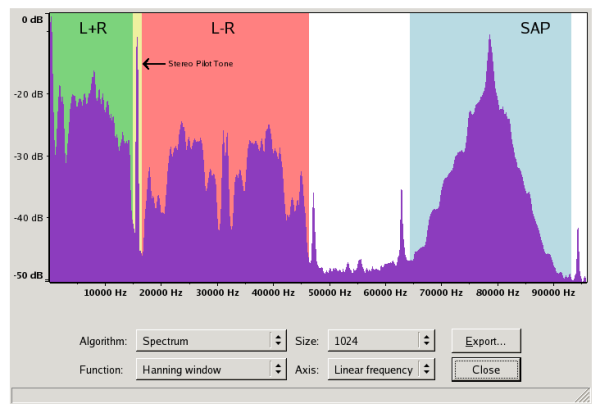
| HOME · MOVIES · HIKING · PHOTOS | SITE MAP | ||
In 1984 the MTS (Multichannel Television Sound) standard, aka BTSC, was adopted and brought stereo audio to North American television. Its design is similar to FM Stereo but there were some technical improvements made to enhance audio quality. As with FM, the wide bandwidth available was used for additional audio programming; these are the SAP (Secondary Audio Program) channel and the PRO (Professional) channel for studio use such as communications with remote crews.
It's easy to find reference material showing what the spectrum of the television audio subcarrier looks like but it's a whole other thing to see it in real life. I had my first exposure to this a few years ago when I connected my TV tuner card's line out to my sound card and saw what the spectrum looked like. That card's maximum sampling rate was 48 kHz, so the resulting spectrum image was only a tease because, while I could clearly see the MTS stereo pilot tone and the lower edge of the double sideband L-R subcarrier, the limited sampling rate kept me from seeing anything above 24 kHz.
This month I bought a new sound card which is capable of a 192 kHz sampling rate. I remembered this experiment and realized that I should be able to see much more of of the audio spectrum now that the new card raised the upper frequency limit to 96 kHz. So I hooked up the TV tuner card, recorded a few seconds of audio with Audacity, and then looked at the spectrum. Here's what I saw, with the different bands annotated and coloured to make them obvious.

Glorious, isn't it! So what does this image show? Let's get technical. Audio is modulated onto an NTSC TV signal using a 4.5 MHz subcarrier of whatever TV channel is being used. This subcarrier is demodulated by the receiver; the resulting audio signal consists of baseband L+R audio (for compatability with mono receivers), the MTS Stereo pilot tone at 15.734 kHz, a double sideband suppressed carrier signal modulated on 31.468 kHz for the L-R audio used to recreate the original stereo, and the FM SAP subcarrier at 78.670 kHz. The Pro channel would be FM at 102.171 kHz but this sound card can't sample high enough to image that part of the spectrum.
Note the mirror-image symmetrical appearance of the L-R envelope. This is typical of a double-sideband or AM signal, but it's nice to actually see it in practice. The FM SAP envelope should also be symmetrical; does the fact that it's not imply lots of noise? The remaining spikes appear to be harmonics of the stereo pilot tone; are these harmonics or deliberate signals?
The end of analogue over-the-air TV broadcasting in Canada in 2011 and the US in 2009 will bring this to an end. It's not yet known what will happen to analogue channels on cable, but hopefully one can study this for some time to come.
| Copyright © 1996-2010 Toomas Losin | Contact | Disclaimer | ||